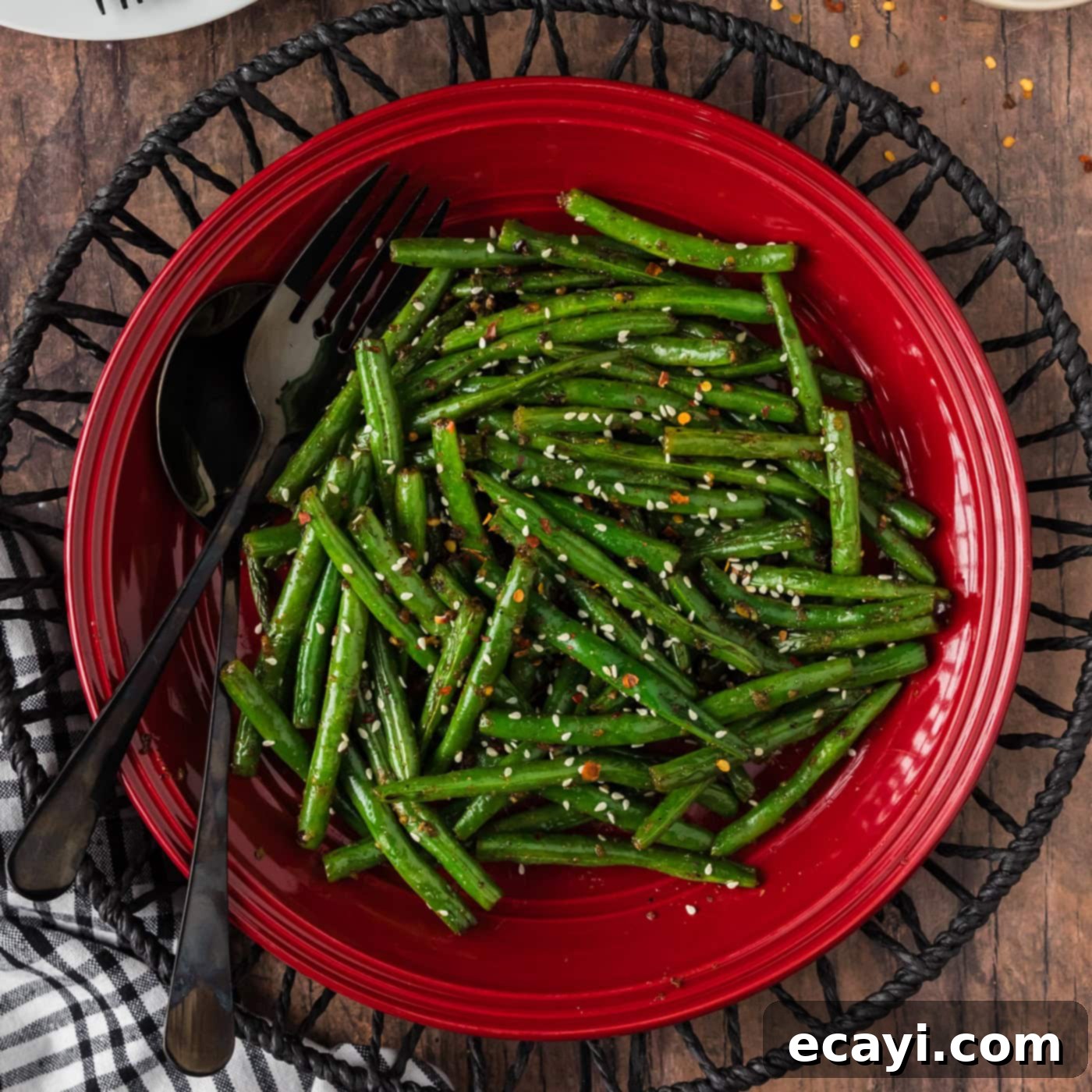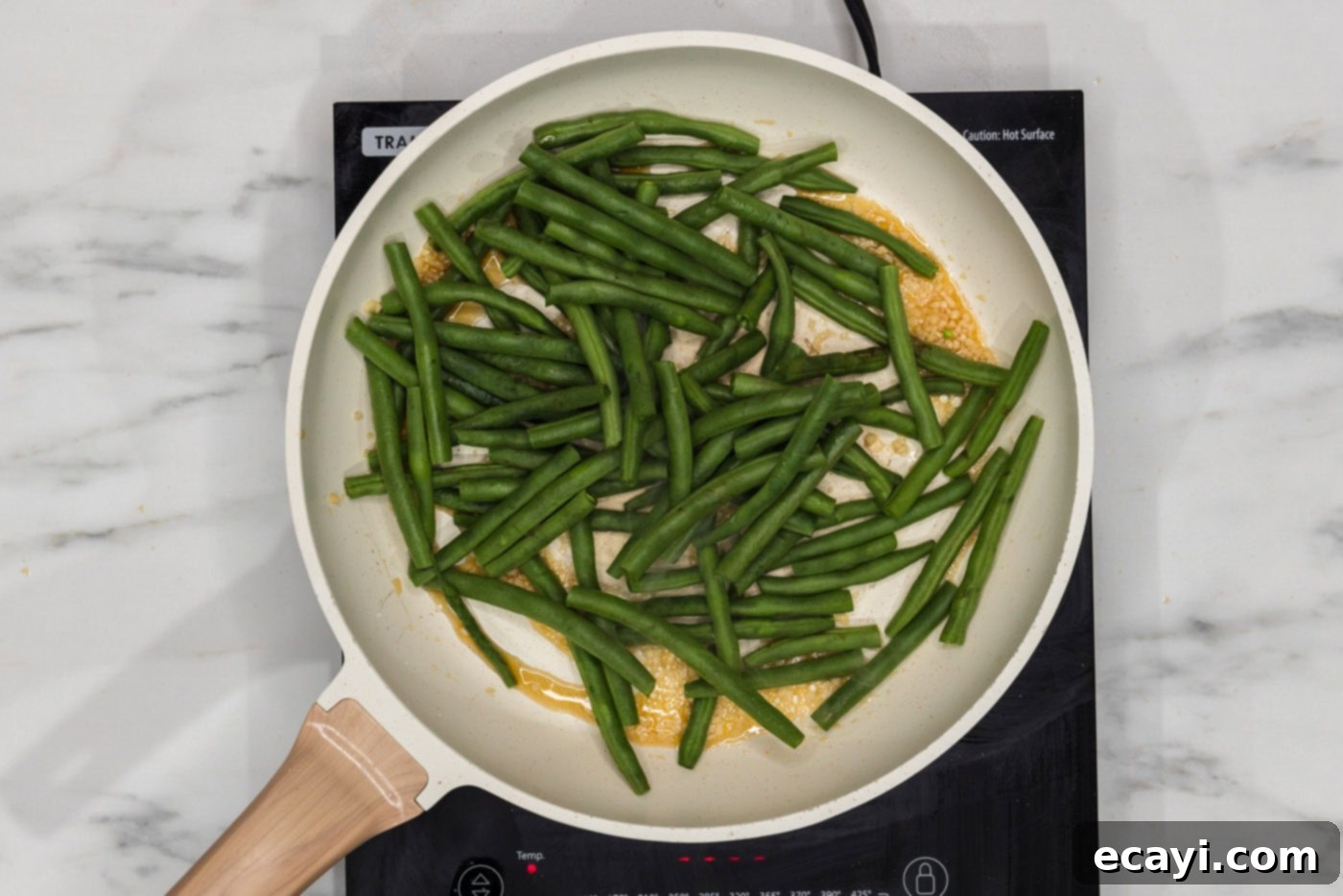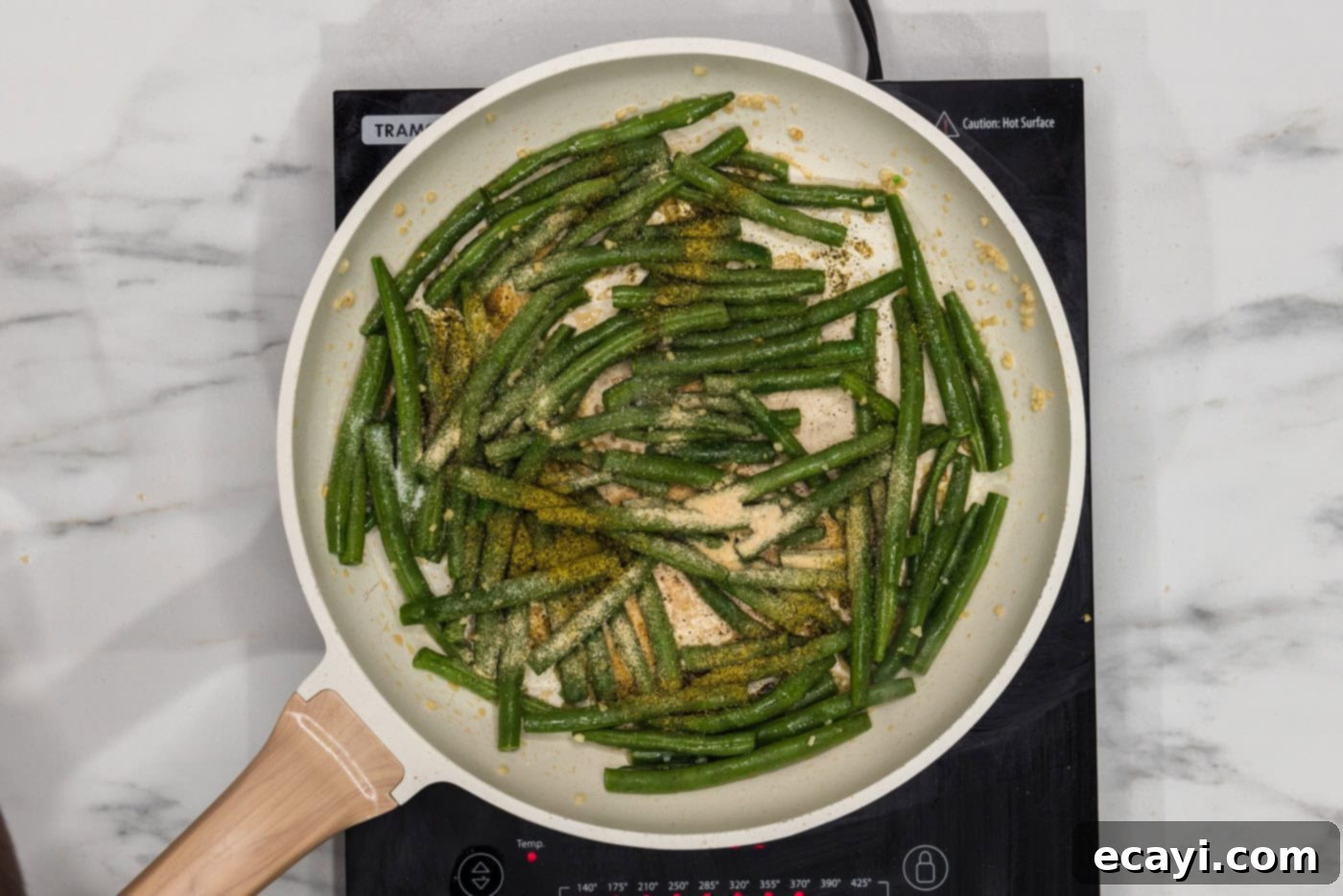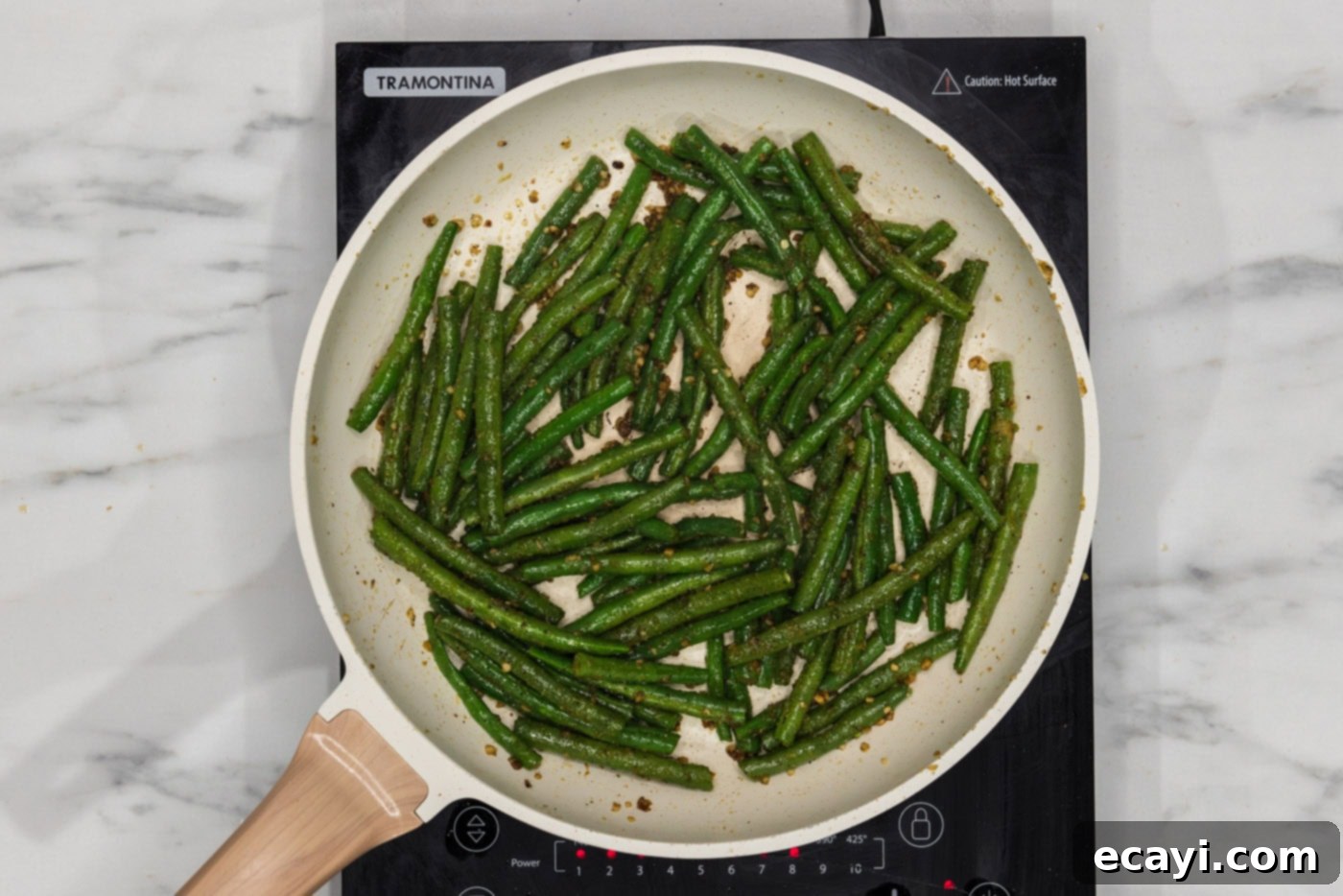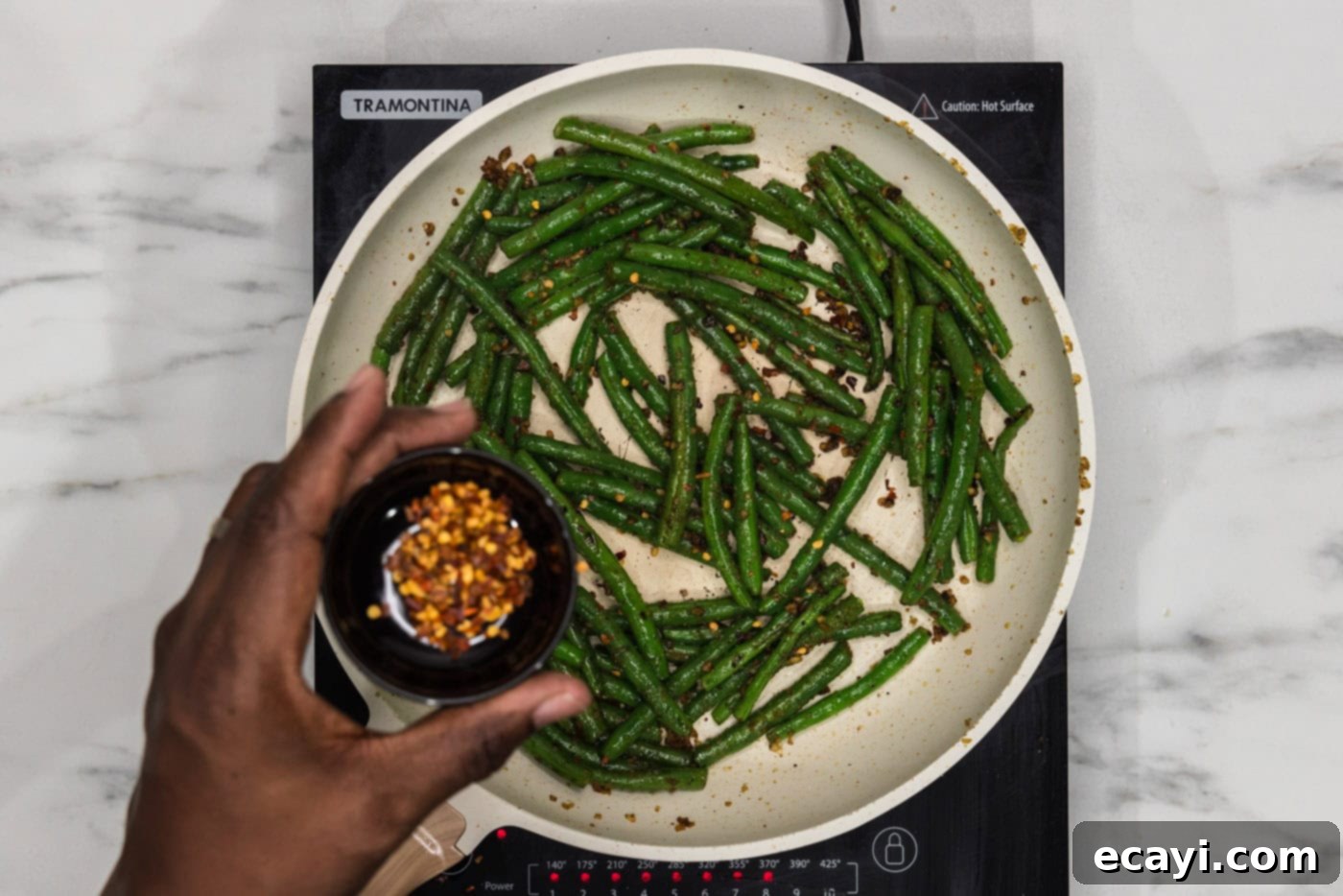Delicious & Easy Skillet Sauteed Green Beans with Garlic and Sesame
Transform fresh green beans into an irresistible side dish in just 20 minutes with this simple skillet recipe. Infused with aromatic sesame oil, savory garlic, and a blend of vibrant seasonings, these sautéed green beans boast a perfect tender-crisp texture without the need for blanching. This hassle-free recipe is ideal for busy weeknights, holiday gatherings, or any meal needing a burst of fresh flavor.
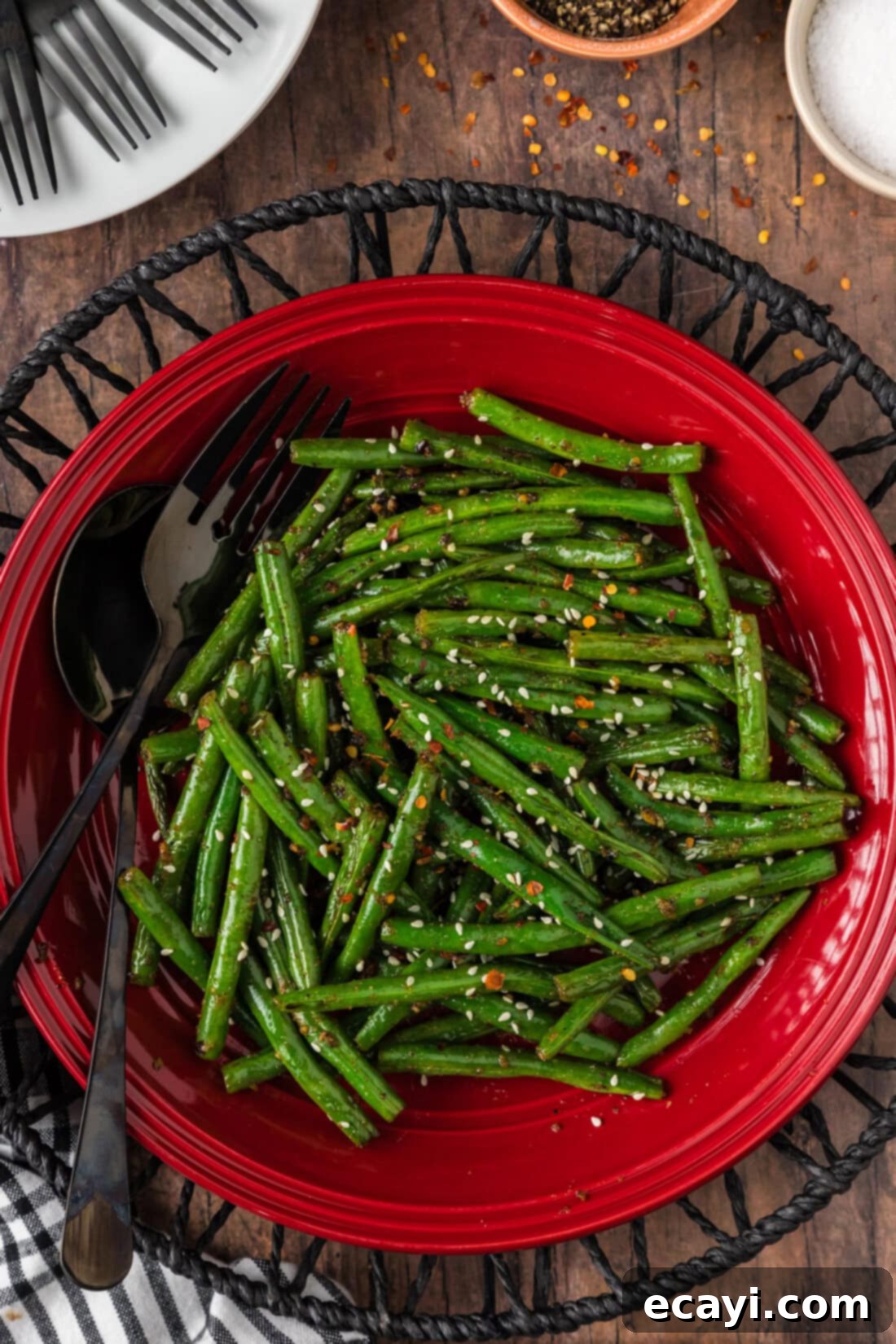
Why This Easy Sauteed Green Bean Recipe Works
Achieving perfectly tender-crisp sautéed green beans is surprisingly straightforward when you know the right technique. This recipe shines because it eliminates the extra step of blanching, making it significantly quicker and more convenient. All you need is your trusty skillet and about 10 minutes of active cook time. The magic lies in the high heat and careful seasoning, which coaxes out the natural sweetness of the beans while building layers of savory flavor.
These skillet green beans are not only fast but also incredibly versatile, pairing wonderfully with almost any main course. They’re a fantastic alternative when your oven is occupied with other dishes, such as a roast or baked potatoes. The combination of rich sesame oil and fragrant garlic creates an aromatic foundation that makes these green beans truly stand out. Learning how to prepare green beans this way will quickly become an effortless part of your cooking repertoire, bringing restaurant-quality flavor to your home kitchen.
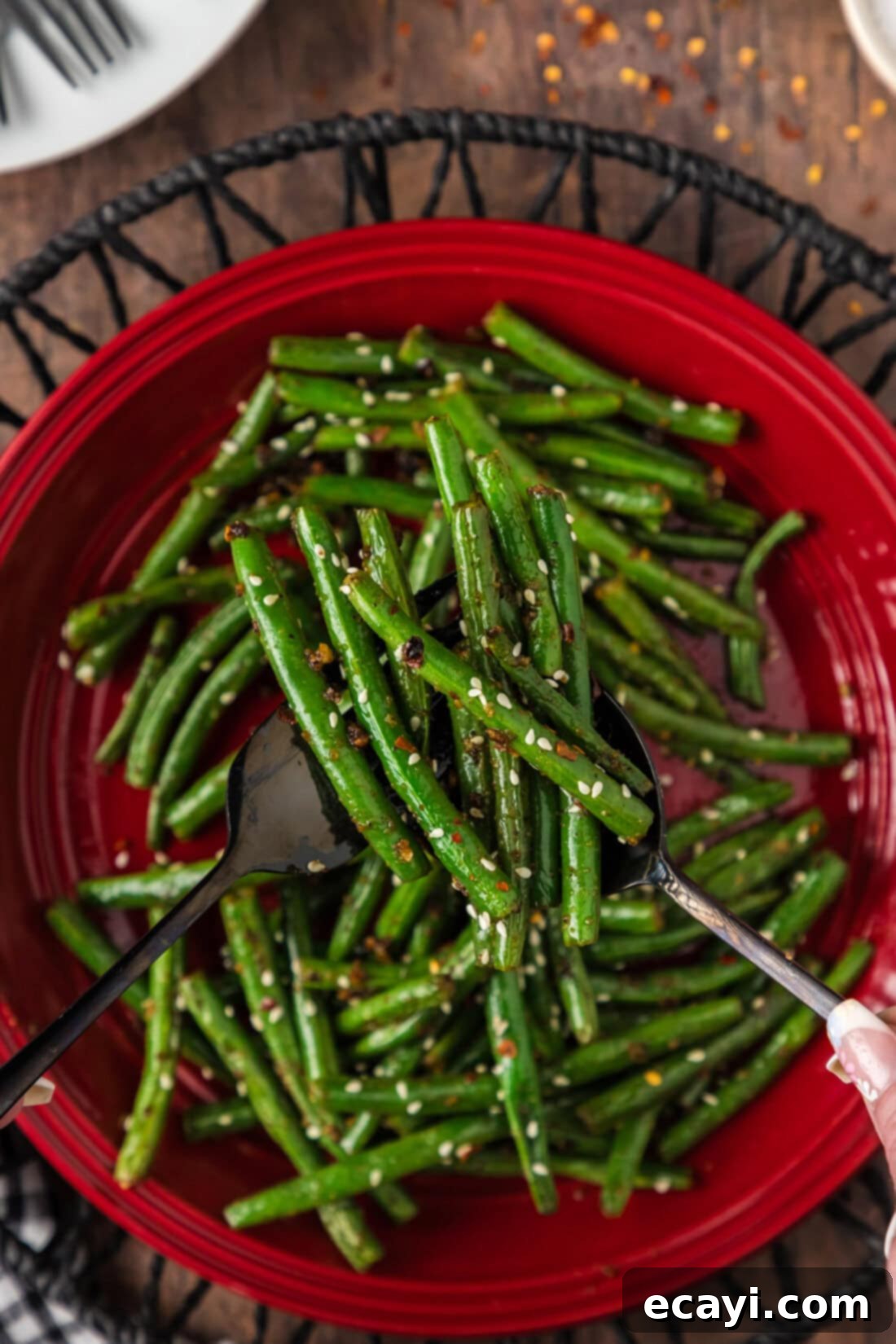
Key Ingredients for Flavorful Sauteed Green Beans
This recipe calls for a handful of fresh ingredients and pantry staples to create a vibrant and delicious side. You’ll find a complete list of measurements and detailed instructions in the printable recipe card at the very end of this post.
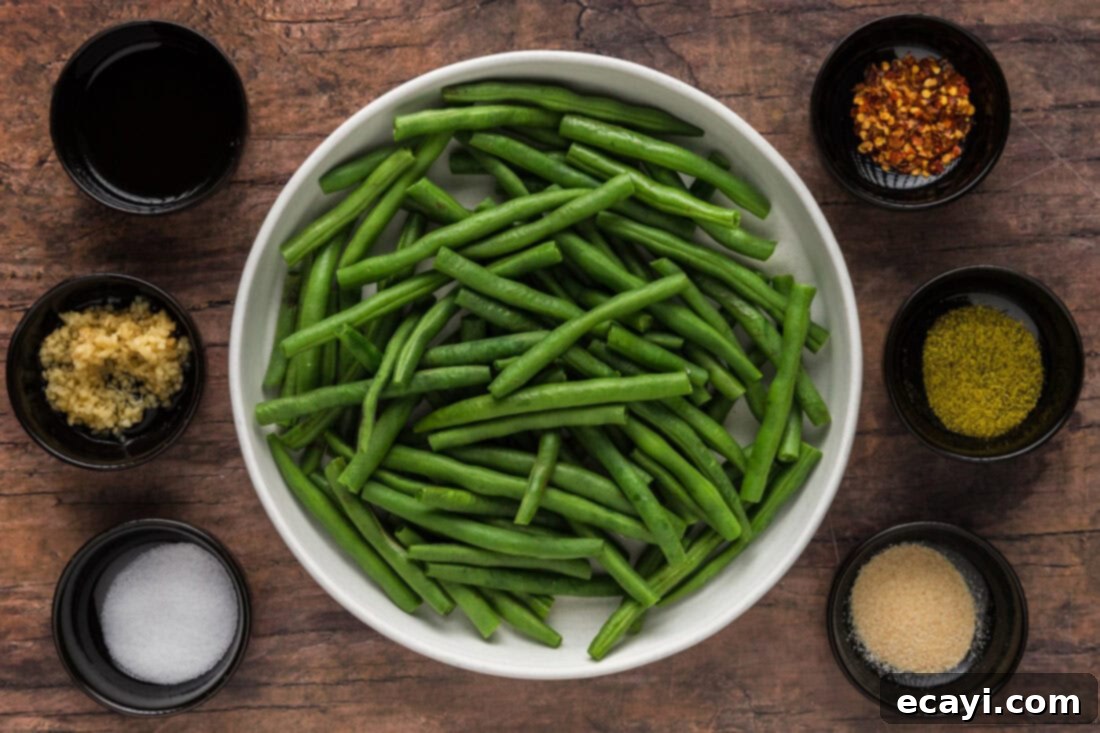
Ingredient Information and Smart Substitutions
- Green Beans: For the best results, always choose fresh green beans that are plump, bright green, and free of blemishes. When you snap one, it should break cleanly, indicating freshness. While you can cut them shorter if you prefer, we love keeping our green beans long for an elegant presentation. Haricots verts, a thinner and more tender variety, also work beautifully if you can find them. Always wash your green beans thoroughly and pat them dry before cooking to prevent steaming.
- Sesame Oil: This ingredient is crucial for imparting a distinctive nutty, aromatic flavor that truly elevates the dish. We recommend using toasted sesame oil (often darker in color) for its more intense flavor profile. If you don’t have sesame oil, or prefer a more neutral taste, olive oil or avocado oil can be used as a direct substitute. However, keep in mind that the unique nutty depth of sesame oil will be absent.
- Minced Garlic: Freshly minced garlic delivers the most potent and delicious flavor. You can mince it finely yourself or use pre-minced garlic from a jar for convenience. Aim for about 1 tablespoon, but feel free to adjust based on your garlic preference. A little extra garlic never hurt anyone!
- Seasonings: The combination of salt, onion powder, and lemon pepper adds a fantastic balance of savory, zesty, and umami notes.
- Salt: Essential for enhancing all other flavors. Use kosher salt or sea salt for best results.
- Onion Powder: Provides a foundational savory depth without the texture of fresh onion, making it perfect for a smooth coating.
- Lemon Pepper: This blend typically includes dried lemon peel, black pepper, and other spices, adding a bright, citrusy, and slightly peppery kick.
- Red Pepper Flakes: These are added to taste for a hint of warmth and subtle spice. If you love heat, feel free to add more! For a milder version, you can reduce or omit them entirely.
- Customization: Don’t be afraid to experiment with other seasonings! A pinch of black pepper, a dash of ginger powder, or even a splash of soy sauce (for an Asian-inspired twist) can be wonderful additions.
How to Make Perfect Sauteed Green Beans
These step-by-step photos and instructions are designed to help you visualize each stage of making this delicious recipe. For a quick jump to the printable version, complete with precise measurements and full instructions, simply Jump to Recipe at the bottom of the page.
- Prepare the Green Beans: Begin by thoroughly washing your fresh green beans under cold water. Then, trim off the tough, stringy ends. You can do this by snapping them off by hand or by lining several up and slicing off the ends with a knife. Pat them dry completely with a clean towel or paper towels – this is crucial for sautéing, as excess moisture can cause them to steam instead of sear.
- Heat the Skillet: Place a large skillet (cast iron or non-stick works well) over medium-high heat. Add the sesame oil and let it heat until it begins to shimmer. This indicates that the oil is hot enough to properly sauté and infuse flavor.
- Sauté the Garlic: Add the minced garlic to the hot oil. Sauté for just one minute, stirring constantly, until it becomes fragrant. Be careful not to let the garlic brown or burn, as burnt garlic can taste bitter. The goal is to release its aromatic oils.
- Add Green Beans: Carefully add the trimmed and dried green beans to the skillet. Toss them immediately with tongs to ensure they are evenly coated with the sesame oil and garlic mixture.

- Season and Cook: Sprinkle the green beans with salt, onion powder, and lemon pepper. Toss them thoroughly again to ensure all the beans are coated with the seasonings. Continue to cook for 5-10 minutes, stirring and tossing frequently. The cooking time will vary depending on how tender or crisp you prefer your beans. For a tender-crisp texture, aim for about 7-8 minutes. Keep them moving in the pan to prevent scorching and to achieve an even cook and slight browning. The beans should turn a vibrant green and develop a slight char in places.

- Final Seasoning: Add red pepper flakes to taste, if desired, for a touch of heat. Sauté for another minute or two, tossing to distribute the spice. Give them a quick taste test and adjust any seasonings as needed before serving hot.


Frequently Asked Questions & Expert Tips
No, it is absolutely not necessary to blanch your green beans before sautéing them for this recipe. Blanching is a technique often used to partially cook vegetables and set their color before further cooking or freezing. However, for skillet sautéing, you can achieve perfectly tender-crisp green beans directly in the pan. Skipping the blanching step saves you time and an extra pot to wash, simplifying the process while still yielding fantastic results. The key is to cook them over medium-high heat, stirring frequently, to ensure they cook evenly and maintain their vibrant color and desired texture.
Once your sautéed green beans have cooled completely to room temperature, transfer them to an airtight container. Store them in the refrigerator for 3-4 days. To reheat, the best method is to gently warm them in a skillet over medium-low heat until they are warmed through, which helps maintain their texture. You can also microwave them, but be careful not to overcook, as they can become soggy. We generally do not recommend freezing sautéed green beans, as their delicate texture tends to become mushy and unappealing once thawed.
These sautéed green beans are incredibly versatile and welcome many additions! For extra savory depth, try tossing in some crispy cooked chopped bacon, caramelized shallots, or finely diced sweet onion. For a delightful textural contrast, toasted slivered almonds, chopped walnuts, or even a sprinkle of toasted sesame seeds work beautifully. A squeeze of fresh lemon juice or a dash of rice vinegar at the end can add a bright, acidic finish. Other popular additions include a drizzle of balsamic glaze, a spoonful of chili crisp for extra heat and crunch, or fresh herbs like parsley or chives.
While fresh green beans are truly best for achieving that ideal tender-crisp texture and vibrant flavor, you can use frozen green beans in a pinch. If using frozen, it’s highly recommended to thaw them first. You can do this quickly by submerging them (still in their plastic bag) in a bowl of cold water, or by placing them in a colander and running cold water over them until thawed. Once thawed, it’s crucial to pat them thoroughly dry with paper towels to remove as much excess moisture as possible. This step prevents them from steaming in the pan and allows them to properly sauté and brown. Keep in mind that frozen green beans may have a slightly softer texture compared to fresh ones, and their cooking time might be slightly reduced.
A large, heavy-bottomed skillet is ideal for sautéing green beans. Cast iron skillets are excellent because they retain heat very well and distribute it evenly, promoting consistent cooking and beautiful browning. A good quality non-stick skillet also works wonderfully for easy tossing and cleanup. The key is to use a pan large enough to hold the green beans in a single layer or close to it, allowing them to sauté rather than steam.
To get that desired tender-crisp texture, where the beans are cooked through but still have a slight snap:
- **Don’t overcrowd the pan:** Ensure there’s enough space for the beans to spread out and make contact with the hot surface. If your pan is too small, cook in batches.
- **Use medium-high heat:** This allows the beans to cook quickly and develop a nice sear without becoming mushy.
- **Toss frequently:** Stirring often ensures even cooking and prevents scorching on one side, promoting consistent doneness.
- **Monitor closely:** Start checking for doneness around the 5-minute mark. You want them vibrantly green, slightly softened but still firm when bitten into.
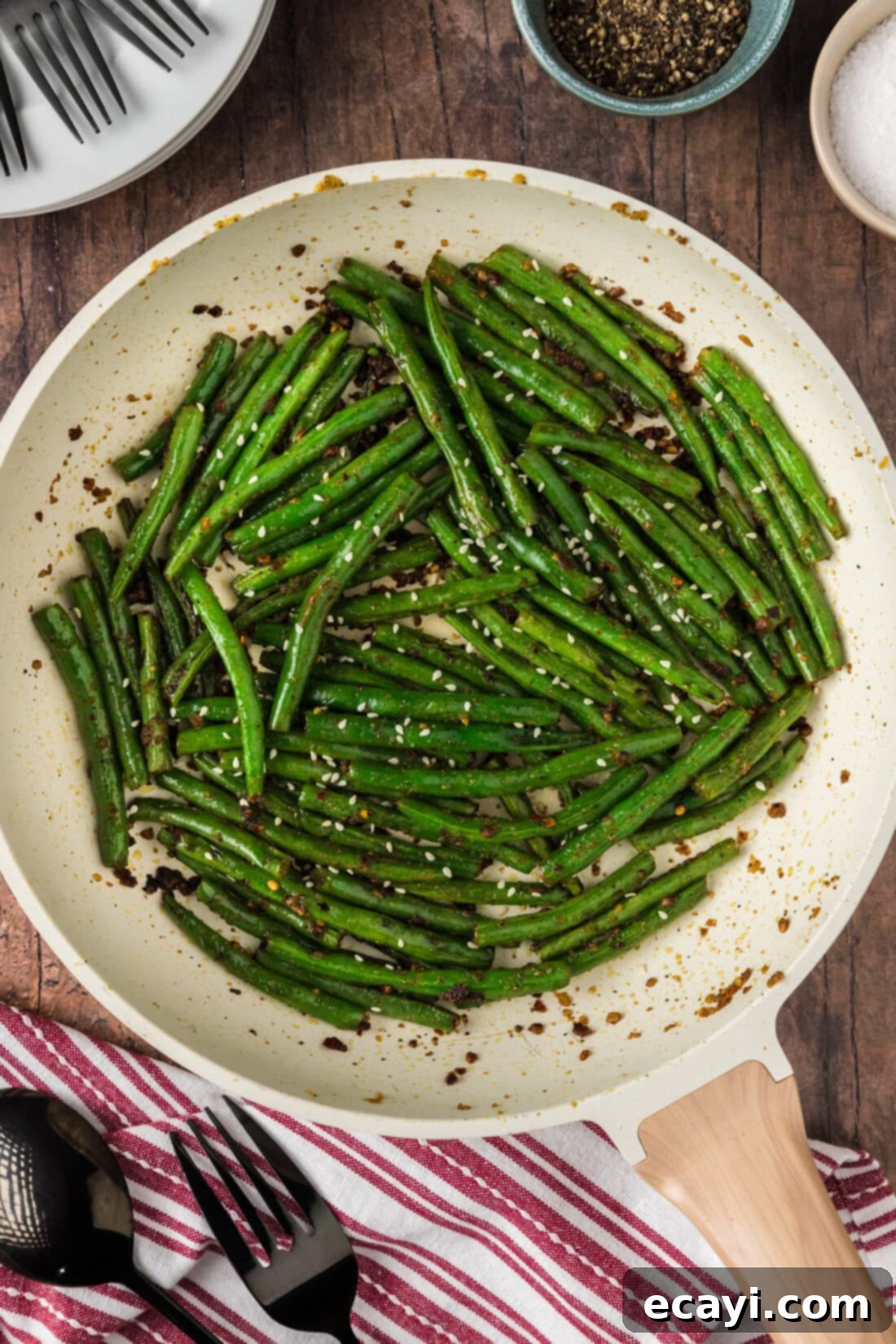
Delicious Serving Suggestions
These flavorful sautéed green beans are a fantastic side dish that complements a wide array of main courses. They pair beautifully with various proteins such as succulent roast chicken, grilled steak, pan-seared fish like salmon or cod, or tender pork chops. Their savory and slightly nutty profile also makes them an excellent accompaniment to vegetarian main dishes, grain bowls, or even as a vibrant addition to a holiday spread. Whether it’s a casual weeknight dinner or a special occasion, you truly can’t go wrong with a classic, well-prepared side of green beans.
More Green Bean Recipes to Explore
- Garlic Green Beans
- Roasted Green Beans
- Air Fryer Green Beans
- Instant Pot Green Beans
I love to bake and cook and share my kitchen experience with all of you! Remembering to come back each day can be tough, that’s why I offer a convenient newsletter every time a new recipe posts. Simply subscribe and start receiving your free daily recipes!
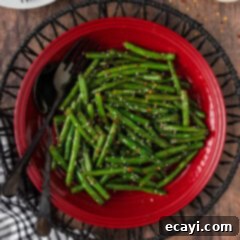
Sauteed Green Beans
No blanching needed! This quick and easy recipe uses a single skillet and just 10 minutes of cook time to create perfectly tender-crisp sautéed green beans.
Cuisine: American
Servings: 4 servings
Total Time: 20 mins
Calories: 75
Author: Amanda Davis
IMPORTANT – There are often Frequently Asked Questions within the blog post that you may find helpful. Simply scroll back up to read them!
Pin It
Rate It
Ingredients
- 1 pound fresh green beans
- 1 Tablespoon sesame oil
- 1 Tablespoon minced garlic
- 1 teaspoon salt
- 2 teaspoons onion powder
- 2 teaspoons lemon pepper
- red pepper flakes to taste
Things You’ll Need
- Large skillet
Before You Begin
- Choose plump fresh green beans that are free of blemishes. We prefer our green beans long as they look nicer for presentation. You can cut yours shorter if you like.
- Fresh green beans are truly best here, but in a pinch you can use frozen green beans. I would recommend letting them thaw first. You can thaw them quickly submerged (in a plastic bag) in a bowl of cold water. Or, simply place them in a colander and run them under cold water until thawed. Then, pat them dry and toss them in the skillet continuing with the recipe instructions.
Instructions
- Trim the ends off the green beans.
- Heat sesame oil in a skillet over medium-high heat until shimmering.
- Add garlic and sauté for one minute.
- Add green beans and toss to coat.
- Sprinkle with salt, onion powder, and lemon pepper, tossing to coat. Cook for 5-10 minutes, depending on how done you like your beans. Toss frequently so beans don’t scorch.
- Season to taste with red pepper flakes and sauté another minute or two.
Expert Tips & FAQs
- Store cooled leftovers in an air-tight container kept in the refrigerator for 3-4 days. Reheat in a skillet over medium-low heat until warmed through. We would not recommend freezing your sautéed green beans as they lose their ideal texture once thawed.
Nutrition
Calories: 75cal |
Carbohydrates: 10g |
Protein: 2g |
Fat: 4g |
Saturated Fat: 1g |
Polyunsaturated Fat: 2g |
Monounsaturated Fat: 1g |
Sodium: 589mg |
Potassium: 271mg |
Fiber: 4g |
Sugar: 4g |
Vitamin A: 788IU |
Vitamin C: 15mg |
Calcium: 54mg |
Iron: 1mg
Follow on Pinterest @AmandasCookin or tag #AmandasCookin!
The recipes on this blog are tested with a conventional gas oven and gas stovetop. It’s important to note that some ovens, especially as they age, can cook and bake inconsistently. Using an inexpensive oven thermometer can assure you that your oven is truly heating to the proper temperature. If you use a toaster oven or countertop oven, please keep in mind that they may not distribute heat the same as a conventional full sized oven and you may need to adjust your cooking/baking times. In the case of recipes made with a pressure cooker, air fryer, slow cooker, or other appliance, a link to the appliances we use is listed within each respective recipe. For baking recipes where measurements are given by weight, please note that results may not be the same if cups are used instead, and we can’t guarantee success with that method.
